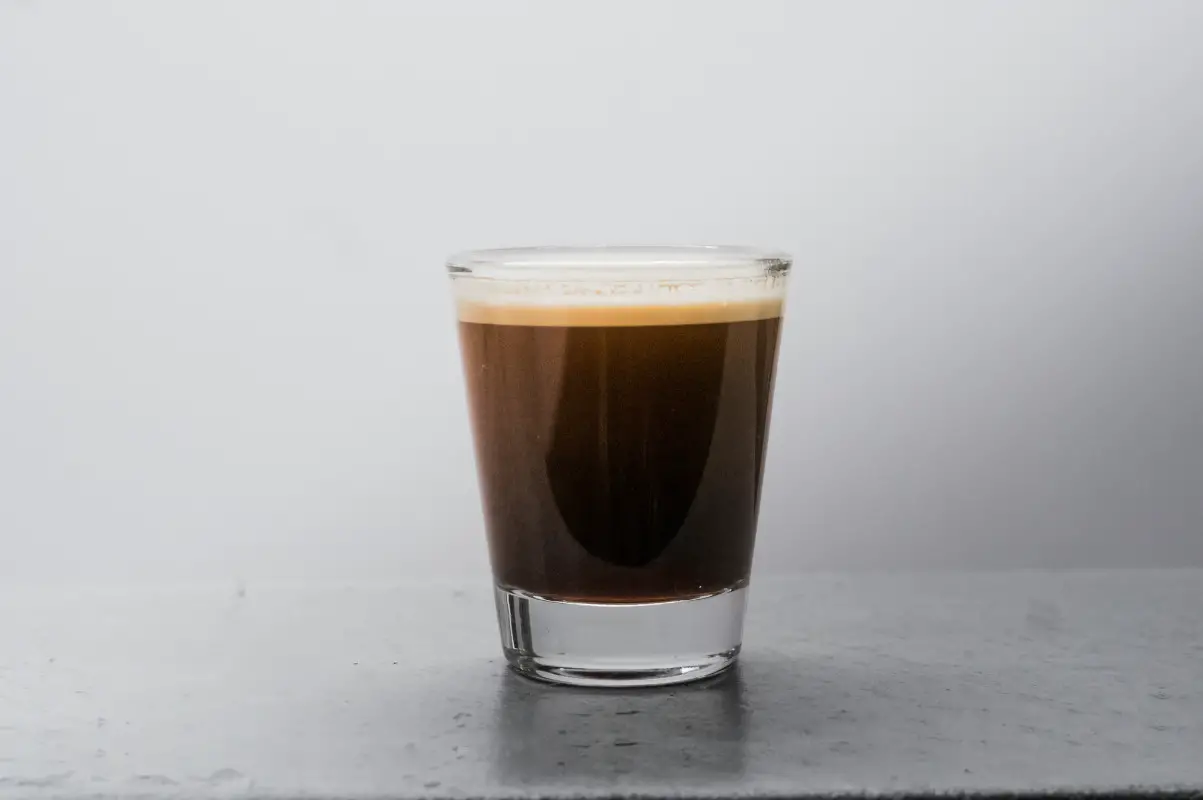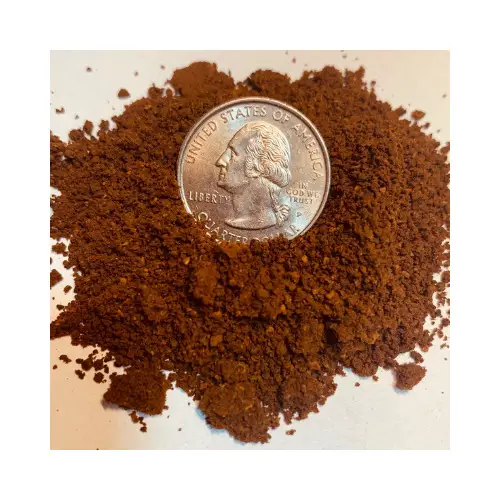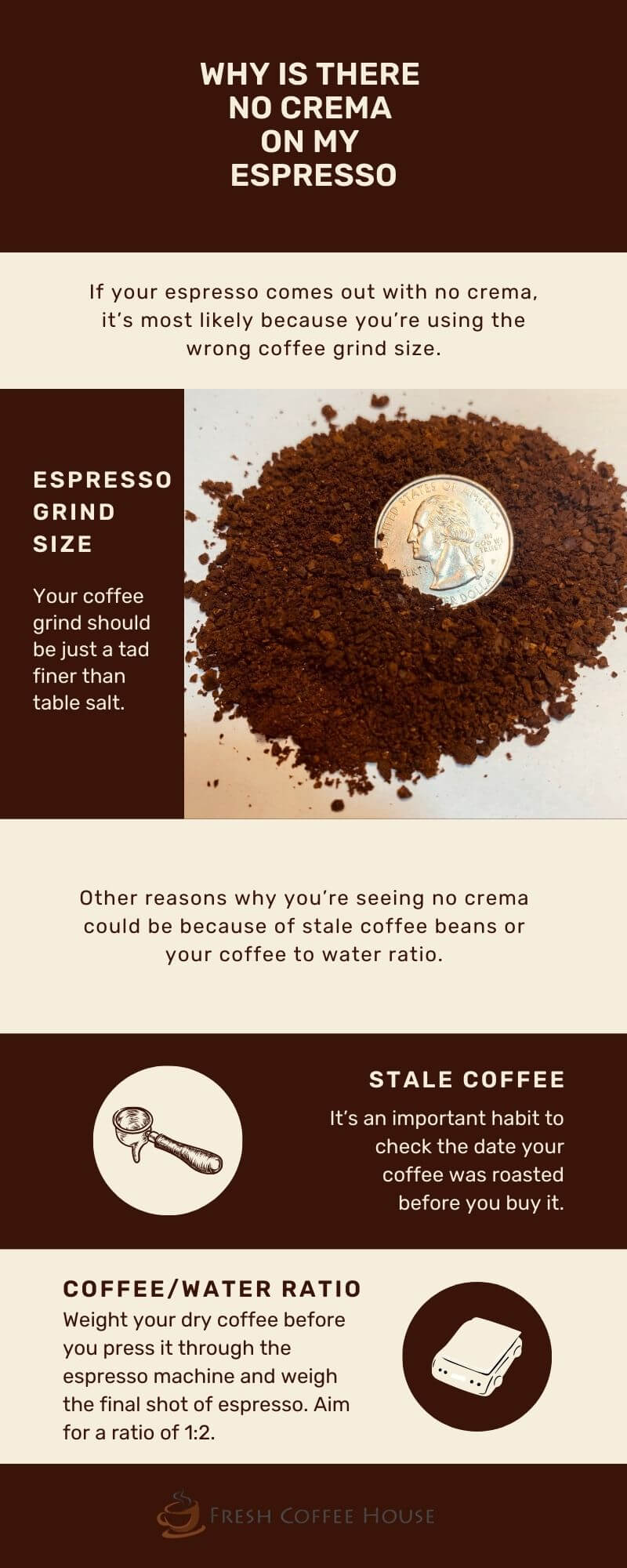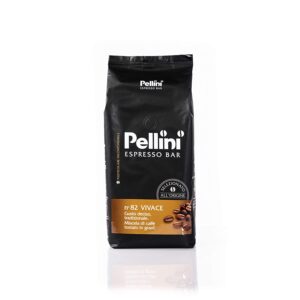
Making delicious, rich espresso is an art, so don’t worry if yours didn’t come out right if you haven’t had practice. When I started pulling shots myself, they used to come out lifeless and bittersweet. I would stare at my demitasse and wonder why there’s no crema on my espresso.
If your espresso comes out with no crema, it’s most likely because you’re using the wrong coffee grind size. Your coffee grind should be just a tad finer than table salt. Other reasons why you’re seeing no crema could be because of stale coffee beans or bad water pressure.
Once I got my grind size exactly right, my espresso began to take on life. It looks and tastes heavenly. While I was troubleshooting the issue, I came across a couple of less common reasons why you could be missing out on the crema. I’ll start with the grind size and work my way through each issue so you can make a perfect espresso as well.
Fixing Grind Size to Get Crema
Getting the perfect coffee grind size can potentially fix all your problems, so it’s the right place to start. The ideal size of your grounds should resemble powdered sugar.
When the coffee grind is too fine it blocks water from seeping through the filter. Your stream will appear unsteady and your shot won’t have any crema.
On the other hand, if your grind is too coarse the water will travel through the coffee too fast leaving you with a hot mess. Water needs a little bit of time to emulsify with the oils from espresso that create crema. If your grind is too coarse you need to crank up that grinder just a little bit.
So how do you get that perfect grind size? It starts with the right coffee grinder. Fine grind, perfect for espresso, is best achieved with a burr grinder. The reason coffee enthusiasts trust burr grinders is that they always produce a batch of evenly ground beans.
Once I got a burr grinder the quality of my espresso improved dramatically. If you don’t already know the difference between blade and burr grinders, I put together this guide to help you.
To get the right grind size for espresso, using a burr grinder, you need to use setting number 1. It’s the finest grind they can produce.
If you’re using an automatic blade grinder you want to hold down the cap for about 30 seconds to achieve a fine grind.

A shot of espresso should take 20-25 seconds to pull. If the espresso machine is taking less time the grind is too coarse, and if it’s taking longer that means your coffee is too fine.
If your grind is perfect but your espresso still has not crema it could be because:
- The coffee is stale
- Your coffee to water ratio is wrong
- Too much water pressure in your machine
- You’re using RO water
Stale Coffee Doesn’t Produce Crema
If your coffee was roasted over three weeks ago, you’re likely to see no crema on your espresso.
Don’t be surprised to find out that most of the coffee in your local grocery store isn’t fresh at all. Now tackle on a couple of days, or weeks, that your coffee has been sitting on that shelf at home. Even though there are ways to keep coffee fresh for longer.
Stale coffee is the second most common reason why people aren’t seeing crema on their espresso.
It’s an important habit to check the date your coffee was roasted before you buy it. Try to make sure you get a fresh batch every time. Buying smaller portions of coffee instead of getting it in bulk can solve that issue as well.
I’ve broken that rule once or twice and bought a bulky bag of beans thinking I could make my way through them all. Unfortunately, after a while, I started to pour entire mugs down the drain before eventually tossing the rest in the trash.
If you’ve figured out the ideal grind size but still aren’t seeing any crema on your espresso, then you need to try using fresh coffee beans. Visit a local café and pick up a small bag of dark roast and you’re likely to see a big difference.
Coffee to Water Ratio

Getting the right coffee to water ratio can be a crucial part of the brewing process. Especially when you’re aiming for that delightful crema topping.
It seems the coffee community can’t agree on most coffee-related ratios, but these espresso measurements are universal. Weight your dry coffee before you press it through the espresso machine and weigh the final shot of espresso. Aim for a ratio of 1:2.
That means for every 1 portion of dry coffee grounds you used to make the shot; it should weigh double in liquid form.
On average, an espresso filter will hold 18 grams of dry coffee, which means your shot of espresso should weigh roughly 36 grams when it’s done.
Using too much water or not enough coffee will likely result in little or no crema.
Other Reasons Why There’s No Crema on Your Espresso
To get the coffee’s fats and oils to produce crema you should be using between seven to nine bars of pressure. Most espresso machines are set to nine bars so make sure you haven’t changed the settings on your appliances. If you have a manual option for pressure setting, make sure you are using nine bars of pressure.
Even though it’s unlikely that reverse osmosis water is the reason you’re seeing no crema on your espresso it is known that RO water is a crema killer. If you’ve been using this kind of water the whole time, try switching it out for regular filtered, or bottled water.
Do Capsule Coffee Machines Make Crema from Pods?
The short answer is yes, you still get crema when you make espresso from a pod or capsule. Although, if you ask any long-time coffee drinker, they will tell you there’s no comparison between the two. Largely because the physical and chemical reactions that make the crema aren’t authentic in capsule machines.
Even though your Nespresso or Keurig can make a shot of espresso the crema is nothing like what you get from a real espresso machine. Pod coffee makers are reliable, simple, and consistent, and make coffee at the push of a button. They should brew the same quality espresso every time.
On the other hand, a real espresso machine takes time to master. The quality of your brew and crema will be altered by nearly a dozen variables. Coffee beans, grind size, water quality, water pressure, and extraction are just a few of the components of making a perfect espresso.
Even though you can still get crema from a capsule coffee machine it’s nothing like the real thing. Especially when you see them side by side.
Wrapping Up
I know if you follow the suggestions I outlined in this article you’re going to see that heavenly foam on top of your espresso. Try to troubleshoot the process in the same order that I listed here.
- Adjust your coffee grind size.
- Make sure your coffee is fresh (no more than 3 weeks old).
- Get your coffee to water ratio right.
- Check the pressure of your espresso machine. Aim for 9 bars of pressure.
- Make sure you are using filtered water.
You have all the information you need to make perfect espresso crema every time.
Related Questions
What Should Espresso Crema Look Like?
It should look like a rich velvety foam made up of tiny bubbles. The colors you want to see should be between light and hazel brown. It’s important to know, crema should have a multicolored texture. Perfect crema should count for a quarter of the total height of your espresso.
What Does Crema Taste Like?
Espresso crema should have a bitter flavor. In most cases, the crema will be slightly more bitter than the actual shot of espresso. Although crema doesn’t change the taste of an espresso, the quality or absence of crema is a way of grading the overall quality of an espresso.

References
How Does Pressure Affect Espresso Quality: https://perfectdailygrind.com/2017/06/how-does-pressure-affect-espresso-quality/
Perfect Espresso: https://www.chefsteps.com/activities/the-espresso-recipe
I’ve always seen coffee as a way of bringing people together. Everywhere I go people seem to enjoy a fresh cup of coffee and that’s what drives my passion. There’s always a new brew to master, and there’s always a new face to enjoy it with. Hitch a ride with me on a coffee-fueled adventure to find a perfect cup.


